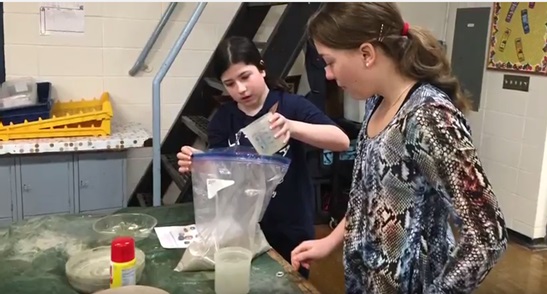Stephanie Enright, at left, and Alexis Denny work on a stepping stone project to fight hunger. Photo by Jessica Steeley
BY JESSICA STEELEY
Clarkston News Staff Writer
Students throughout the district are serving the community at record levels this year.
“For public education, for a public school district, it’s phenomenal to have 50 percent of your staff and students engaged in service learning,” said District Academic Service Learning Coordinator Radhika Issac.
Projects range from Young Fives to 12th graders, Issac added
ASL first came to the district 14 years ago, in 2007, she said.
Though it is not required for students or teachers to participate, over 150 teachers and over 4,000 students engage in the program. Since ASL is its own program, it has a budget which helps teachers fund their projects.
“Academic service learning is taking any curricular requirements we teach our students and connecting it to a real-world issue,” Issac said.
Students get an opportunity to practice real-world skills and connect with what they’re learning. Issac gave an example as she described a third grade ASL project centered around literacy.
The project paired the class with a children’s home in Honduras to help build a library to promote literacy for those children. The library included an informational book the third graders wrote themselves and published. Besides just promoting literacy, the inclusion of their published book showed the Honduras children anyone can be a reader and writer.
“That’s what service learning does, it really puts students out there into the real world and say ‘How can I impact the world as a scientist, or as a social scientist, or a mathematician, or a reader or writer?’” Issac said.
If an educator wants to learn more about ASL, or strengthen the work they’re doing with the program, Issac invites them to attend one of the full-day ASL workshops offered at the Clarkston Community Schools administration office.
“The workshops are hugely beneficial,” said Kristen Vigier, a sixth grade teacher. “There’s a learning piece for us and then there’s also a service piece for us. We go and we can connect with different community members. Then, we’re given time to brainstorm and create and put together our project.”
Corena Bell, a first grade teacher at Independence Elementary who helps train teachers in ASL, said Clarkston is fortunate the district sees ASL as important work and is willing to support teachers by offering these workshops.
“They do think quality matters. So the more planning and preparation, the higher the quality of course, the deeper the learning and the better the project ,” Bell said. “You can always deepen it. There’s always more you can do with it.”
Bell described the S.O.C.K.S. program at Independence Elementary, which stands for Serving our Community Kids Style. It centers around a school-wide ASL project where every grade spends time learning about a different cause, and pairs with a community partner as part of S.O.C.K.S. Day.
“We’re creating and helping our young learners become ready for the 21st century. They have to do problem solving,” she said. “They connect and make relationships and all those things are important as they move forward in their lives.”
Some examples of other projects are buddy benches, making blankets for hospitalized children and penny drives.
“Academic Service Learning is very flexible, it can be a project for very young learners all the way through high school and secondary. A lot of universities also support academic service learning,” Bell said.
ASL allows students to participate in several service learning projects throughout their time in the Clarkston district.
A few students from Mr. Pierson’s seventh grade class recall some projects they worked on.
“I did one in fourth grade where we made blankets and then sent it to kids who had cancer in hospitals,” Andrew Sesti said, adding the project taught him how to make blankets. “They were pretty fun. We got to work together with our friends to help other people.”
Allie Kujala remembers having fun planting sunflower seeds in early elementary school for one of the projects.
“We just started the salmon project in this class and we’re learning about ecosystems. It connects to that,” Kujala said of the ASL project happening in her seventh grade class.
“There was one in fourth grade where we went over to one of the poorer areas and we helped with a community garden. We provided information about how and when to plant things,” Hana Chrenka said.
Chrenka could connect many of her ASL projects to what she was learning in class and also learned life skills.
Vigier believes ASL has a huge impact on students by allowing them to have their own voice and ideas while helping others. The program helps pull everyone together and allows the students, teachers and community partners to connect.
Teachers enjoy the empowerment they give to their students through the projects, as well as themselves. The projects allow teachers and students more creative freedom in the classroom, she added.
Bell said teachers also benefit from having motivated, engaged students who are interested in and listening to the teacher because they understand the importance of the work they do through ASL projects.
“It’s also a great benefit for the community. We’re addressing a need, but at the same time it’s a reciprocal in our relationship because now our community begins to see us as a resource and our students as important, viable resources for them,” Bell said.
“Clarkston students and community and teachers are really fortunate to have something like this to support this idea of community service and bringing service into the classroom,” Issac said.
“It’s exciting to be in Clarkston and to see where this is going to grow. We’d love to continue to grow this and get closer and closer to 100 percent.”

